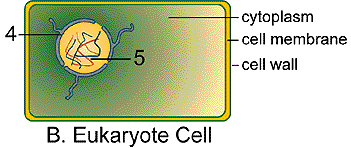

click here to go back to the readings press
1. The answer is "d". Prokaryotes are the more primitive cell types which lack most of the membrane bound organelles. Bacteria and blue green algae are examples of prokaryotes. Eukaryote organisms consists of cells containing many membrane bound organelles. Higher plant and animal cells are made of eukaryote cells. Examine the cell types below.


click here to go back to the readings press
2. The answer is "b" nucleoid. The genome is the total genetic
makeup of a cell and is located on DNA molecules of the nucleoid of prokaryotes
or the nucleus of eukaryotes.
click here to go back to the readings press
3. The answer is "b" binary fission. You may want to check the glossary
of the text for a definition for this term. Prokaryote cells and the two
organelles replicate by binary fission. This process will be explained
later in this program.
click here to go back to the readings press
4 and 5. The answer for 4 is "c" and for 5 is "d". This is a
eukaryote cell with it's DNA in the nucleus in the form of chromosomes.
This figure represents an eukaryote cell which may replicate by mitosis
or meiosis.
click here to go back to the readings press4
6. The answer is "d". There are four mitochondria represented in this
figure and they are all self replicating by binary fission..
click here to go back to the readings press
7. The answer is 1. circular DNA lacking nuclear membrane
2. cell membrane or cell wall
3. cytoplasm containing ribosomes
Draw figure below in your notes.

click here to go back to the readings press
8. The answer is 4 - nuclear envelope Note that it consists of
a double membrane.
5 - chromatin This structure consists of protein and
DNA molecules.

click here to go back to the readings press
8a. The answer is 6 - circular DNA in the chloroplast

click here to go back to the readings press
9. The answer is 7 -. circular DNA in the mitochondrion

click here to go back to the readings page
10. The answer is "e". All three of these replicate by binary
fission.
click here to go back to the readings press
11. The answer is "c". Eukaryote cells contain their DNA in the form
of linear threads surrounded by a double membrane structure.
click here to go back to the readings press
.
12. The answer is "c". Eukaryote cells contain a double membrane
surrounding the DNA.
click here to go back to the readings press